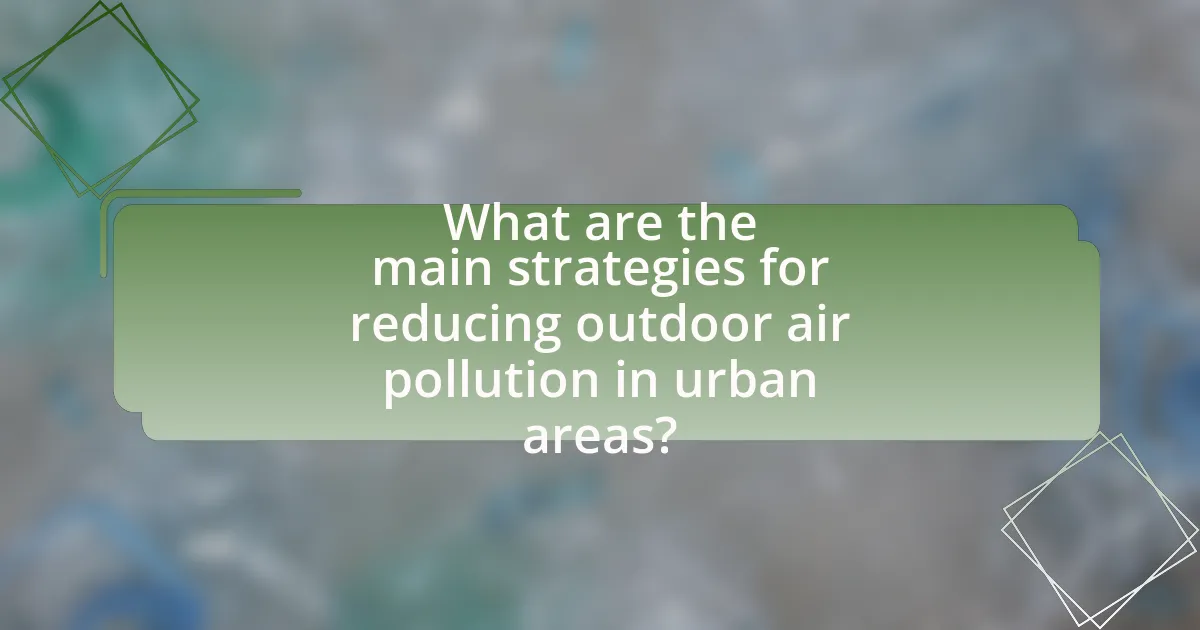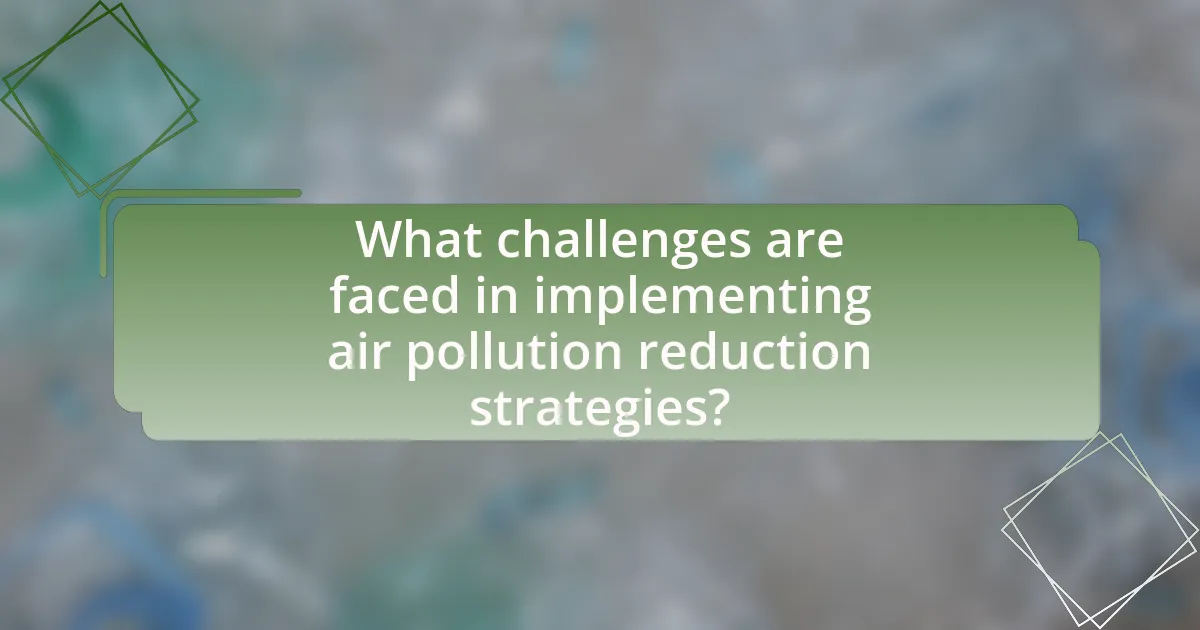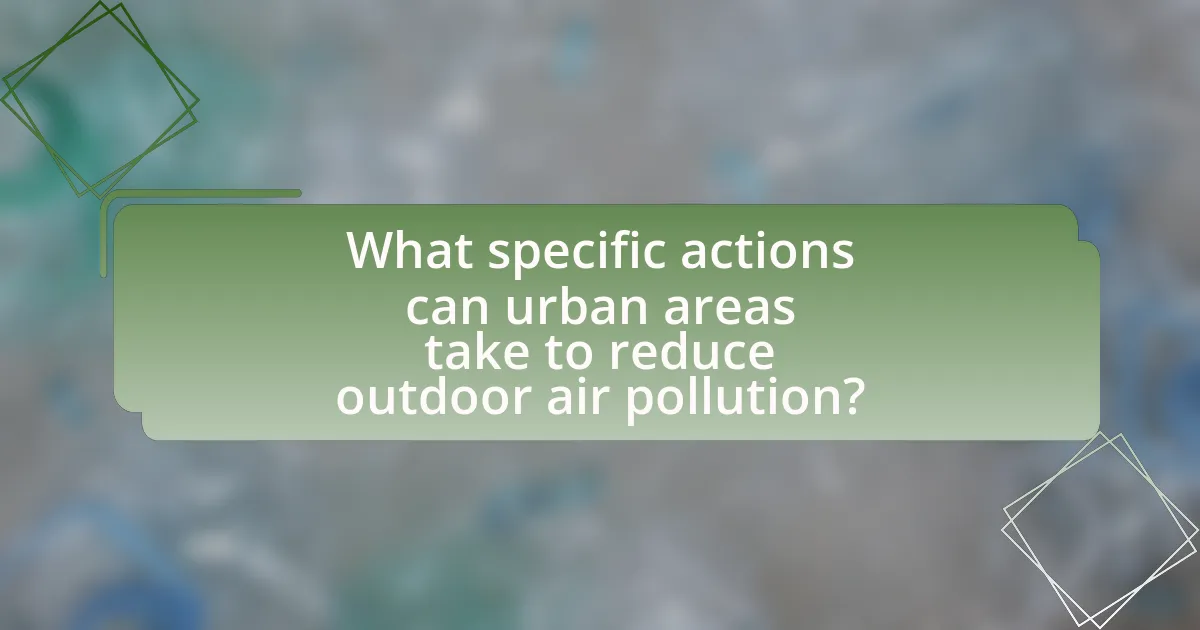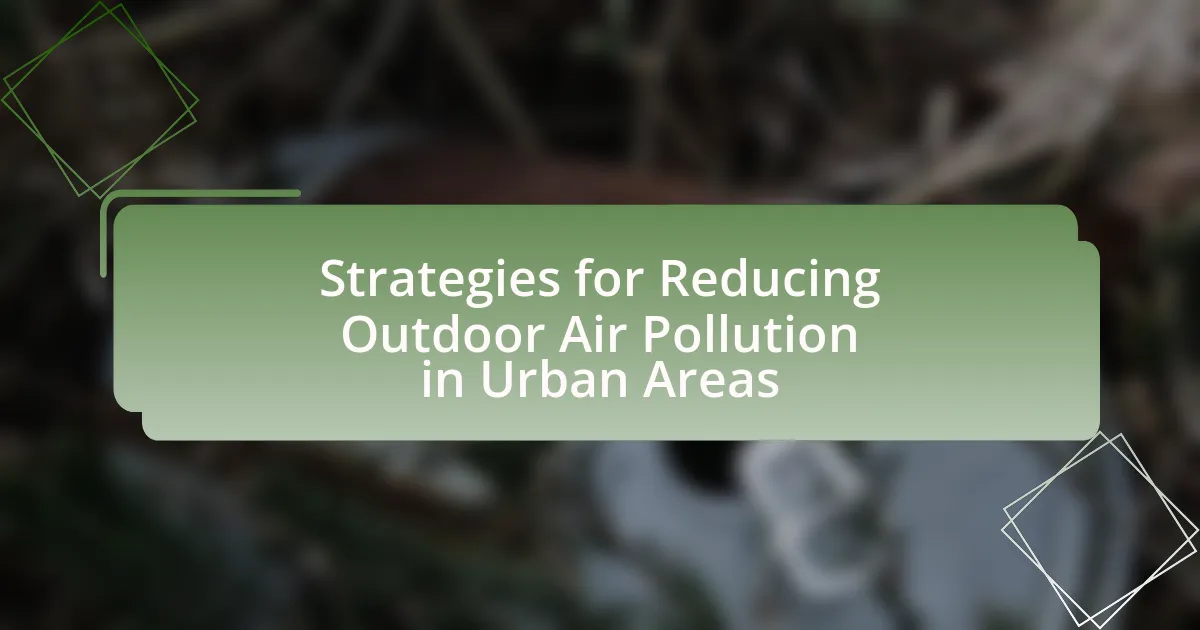The article focuses on strategies for reducing outdoor air pollution in urban areas, highlighting key approaches such as enhancing public transportation, promoting electric vehicles, implementing stricter emissions regulations, increasing green spaces, and encouraging energy efficiency in buildings. It discusses how these strategies target specific pollution sources, the role of transportation policies and urban planning in improving air quality, and the associated public health and economic benefits. Additionally, the article addresses challenges in implementing these strategies, including political resistance and funding limitations, while emphasizing the importance of community engagement and specific actions cities can take to achieve cleaner air.
What are the main strategies for reducing outdoor air pollution in urban areas?

The main strategies for reducing outdoor air pollution in urban areas include enhancing public transportation, promoting the use of electric vehicles, implementing stricter emissions regulations, increasing green spaces, and encouraging energy efficiency in buildings. Enhancing public transportation reduces the number of vehicles on the road, which lowers emissions; for instance, cities that invest in reliable transit systems often see a significant decrease in air pollutants. Promoting electric vehicles further decreases reliance on fossil fuels, as electric cars produce zero tailpipe emissions. Stricter emissions regulations on industries and vehicles ensure that pollutants are kept within safe limits, contributing to cleaner air. Increasing green spaces, such as parks and urban forests, helps absorb pollutants and improve air quality. Lastly, encouraging energy efficiency in buildings reduces energy consumption and associated emissions, as buildings account for a substantial portion of urban air pollution.
How do these strategies address specific sources of air pollution?
These strategies effectively target specific sources of air pollution by implementing measures that reduce emissions from transportation, industrial activities, and residential heating. For instance, promoting public transportation and electric vehicles directly addresses emissions from gasoline and diesel-powered vehicles, which are significant contributors to urban air pollution. Additionally, enforcing stricter regulations on industrial emissions helps to minimize pollutants released from factories, thereby improving air quality. Furthermore, incentivizing the use of cleaner heating methods in homes, such as electric or renewable energy sources, reduces the particulate matter and volatile organic compounds emitted from traditional fossil fuel heating systems. These targeted approaches are supported by studies indicating that cities adopting such strategies have seen measurable improvements in air quality and public health outcomes.
What role do transportation policies play in reducing air pollution?
Transportation policies play a crucial role in reducing air pollution by regulating vehicle emissions, promoting public transit, and encouraging the use of cleaner technologies. These policies can include measures such as stricter emissions standards for vehicles, incentives for electric and hybrid vehicles, and investments in public transportation infrastructure. For instance, cities that have implemented congestion pricing or low-emission zones have seen significant reductions in nitrogen dioxide and particulate matter levels, demonstrating the effectiveness of such policies in improving air quality.
How can urban planning contribute to cleaner air?
Urban planning can contribute to cleaner air by promoting green spaces, enhancing public transportation, and implementing strict zoning regulations. Green spaces, such as parks and urban forests, improve air quality by absorbing pollutants and providing oxygen; studies show that urban greenery can reduce particulate matter by up to 30%. Enhancing public transportation reduces reliance on personal vehicles, leading to lower emissions; cities with robust public transit systems, like Tokyo, experience significantly reduced air pollution levels. Additionally, zoning regulations can separate industrial areas from residential zones, minimizing exposure to harmful emissions; for instance, cities that enforce such regulations often report better air quality metrics.
What are the benefits of implementing these strategies?
Implementing strategies for reducing outdoor air pollution in urban areas leads to improved public health outcomes. Studies indicate that reducing air pollution can decrease respiratory diseases, cardiovascular issues, and premature mortality rates. For instance, the World Health Organization estimates that air pollution is responsible for approximately 7 million deaths annually, highlighting the critical need for effective pollution reduction strategies. Additionally, cleaner air enhances the quality of life, promotes environmental sustainability, and can lead to economic benefits through increased productivity and reduced healthcare costs.
How do these strategies improve public health?
Strategies for reducing outdoor air pollution in urban areas improve public health by decreasing the incidence of respiratory diseases and cardiovascular conditions. For instance, implementing stricter emissions regulations and promoting public transportation can lead to lower levels of pollutants such as particulate matter and nitrogen dioxide, which are linked to health issues. Research indicates that cities that have adopted green spaces and increased vegetation experience a reduction in air pollution levels, resulting in improved respiratory health outcomes among residents. A study published in the journal Environmental Health Perspectives found that reducing air pollution can lead to a significant decrease in hospital admissions for asthma and other respiratory conditions, demonstrating the direct impact of these strategies on public health.
What economic advantages can arise from reducing air pollution?
Reducing air pollution can lead to significant economic advantages, including lower healthcare costs and increased productivity. Improved air quality results in fewer respiratory and cardiovascular diseases, which in turn reduces the financial burden on healthcare systems. For instance, a study by the American Lung Association estimated that achieving the National Ambient Air Quality Standards could save the U.S. economy approximately $2.4 trillion in health-related costs by 2030. Additionally, cleaner air enhances worker productivity, as healthier employees tend to take fewer sick days and perform better at work, contributing positively to economic output.
What challenges are faced in implementing air pollution reduction strategies?

Implementing air pollution reduction strategies faces several significant challenges, including political resistance, funding limitations, and public awareness. Political resistance often arises from conflicting interests among stakeholders, such as industries that may be adversely affected by stricter regulations. Funding limitations hinder the development and execution of comprehensive air quality programs, as many municipalities struggle to allocate sufficient resources for necessary infrastructure improvements. Additionally, public awareness and engagement are crucial; without adequate understanding of the health impacts of air pollution, community support for initiatives may be weak. These challenges are evidenced by studies indicating that cities with strong political will and public engagement see more effective implementation of air quality measures, while those lacking these elements often experience stalled progress.
How do political and economic factors influence these challenges?
Political and economic factors significantly influence the challenges of reducing outdoor air pollution in urban areas. Political decisions, such as the implementation of environmental regulations and policies, directly affect the level of pollution control measures enforced. For instance, countries with stringent air quality standards, like the European Union member states, often experience lower pollution levels compared to those with lax regulations. Economic factors, including funding for public transportation and green technologies, also play a crucial role; cities that invest in sustainable infrastructure tend to see improved air quality. According to the World Bank, urban areas that allocate resources towards clean energy initiatives and pollution control technologies can reduce particulate matter by up to 30%. Thus, the interplay of political will and economic investment is essential in addressing the challenges of outdoor air pollution.
What are the common political barriers to implementing air quality initiatives?
Common political barriers to implementing air quality initiatives include lack of political will, competing economic interests, and insufficient public awareness. Political will is often hindered by short-term electoral cycles, where politicians prioritize immediate economic gains over long-term environmental benefits. Competing economic interests arise from industries that may be negatively impacted by stricter air quality regulations, leading to lobbying against such initiatives. Insufficient public awareness can result in low demand for action, making it easier for policymakers to ignore air quality issues. These barriers collectively impede the effective implementation of necessary air quality measures.
How does funding affect the success of pollution reduction strategies?
Funding significantly influences the success of pollution reduction strategies by providing the necessary resources for implementation, research, and technology development. Adequate financial support enables cities to invest in cleaner technologies, enhance public transportation systems, and enforce stricter regulations on emissions. For instance, a study by the World Bank in 2020 highlighted that cities with dedicated funding for air quality initiatives saw a 30% greater reduction in particulate matter levels compared to those without such financial backing. This correlation underscores the critical role of funding in facilitating effective pollution control measures and achieving long-term environmental goals.
What public resistance might arise against these strategies?
Public resistance against strategies for reducing outdoor air pollution in urban areas may arise due to concerns over economic impacts, lifestyle changes, and perceived effectiveness. For instance, residents may oppose measures such as congestion pricing or increased public transportation fees, fearing financial burdens. Additionally, strategies that require alterations to daily routines, such as restrictions on vehicle use or changes in energy consumption, can lead to pushback from individuals who value convenience and personal freedom. Furthermore, skepticism about the actual effectiveness of proposed strategies, especially if previous initiatives have not yielded significant improvements, can foster distrust and resistance among the public.
How can community engagement mitigate resistance to air quality measures?
Community engagement can mitigate resistance to air quality measures by fostering trust and collaboration between local authorities and residents. When communities are actively involved in the decision-making process, they are more likely to understand the rationale behind air quality initiatives and feel a sense of ownership over the outcomes. Research shows that participatory approaches, such as public forums and workshops, lead to increased acceptance of environmental policies. For instance, a study published in the Journal of Environmental Management found that communities that engaged in discussions about air quality improvements reported higher levels of support for proposed measures, demonstrating that informed and involved citizens are less likely to resist changes aimed at enhancing air quality.
What specific actions can urban areas take to reduce outdoor air pollution?

Urban areas can implement several specific actions to reduce outdoor air pollution, including enhancing public transportation systems, promoting the use of electric vehicles, and increasing green spaces. By investing in efficient public transit, cities can decrease the number of individual cars on the road, which contributes significantly to air pollution. For instance, cities like London have seen a reduction in emissions by expanding their public transport networks. Additionally, incentivizing electric vehicle use through subsidies and charging infrastructure can further lower emissions from transportation. Research indicates that electric vehicles produce zero tailpipe emissions, which directly improves air quality. Lastly, increasing green spaces, such as parks and urban forests, can help absorb pollutants and improve overall air quality, as demonstrated by studies showing that urban greenery can reduce particulate matter levels.
How can cities enhance public transportation systems?
Cities can enhance public transportation systems by investing in infrastructure improvements, such as dedicated bus lanes and expanded rail networks. These enhancements increase efficiency and reliability, encouraging more residents to use public transit instead of personal vehicles. For instance, cities like Bogotá have implemented TransMilenio, a bus rapid transit system that has significantly reduced travel times and increased ridership by over 50%. Additionally, integrating technology, such as real-time tracking apps, can improve user experience and accessibility, further promoting public transportation use.
What innovations in public transport can lead to lower emissions?
Innovations in public transport that can lead to lower emissions include the adoption of electric and hybrid vehicles, the implementation of smart traffic management systems, and the development of integrated mobility solutions. Electric and hybrid vehicles significantly reduce greenhouse gas emissions compared to traditional diesel buses; for instance, electric buses can reduce emissions by up to 70% over their lifetime. Smart traffic management systems optimize traffic flow, reducing idle times and emissions; studies show that such systems can decrease emissions by 10-20%. Integrated mobility solutions, which combine various modes of transport (like bike-sharing and public transit), encourage the use of public transport over personal vehicles, further lowering emissions.
How can cycling and walking infrastructure be improved?
Cycling and walking infrastructure can be improved by implementing dedicated bike lanes and pedestrian pathways that are physically separated from motor vehicle traffic. Research indicates that cities with well-defined cycling and walking paths experience a significant increase in active transportation, which contributes to reduced outdoor air pollution. For example, a study by the Institute for Transportation and Development Policy found that cities with extensive cycling networks, like Copenhagen, have seen a 40% reduction in carbon emissions from transportation. Additionally, enhancing connectivity between existing routes and ensuring proper maintenance can further encourage cycling and walking, leading to healthier urban environments and lower air pollution levels.
What role do green spaces play in air quality improvement?
Green spaces play a crucial role in improving air quality by absorbing pollutants and producing oxygen. Trees and vegetation filter harmful particulates from the air, such as carbon dioxide, sulfur dioxide, and nitrogen oxides, effectively reducing urban air pollution levels. For instance, a study published in the journal “Environmental Science & Technology” found that urban trees can remove approximately 711,000 tons of air pollution annually in the United States, highlighting their significant impact on enhancing air quality.
How can urban forestry initiatives contribute to cleaner air?
Urban forestry initiatives contribute to cleaner air by increasing tree canopy cover, which helps filter pollutants and improve air quality. Trees absorb carbon dioxide and release oxygen through photosynthesis, while also trapping particulate matter and other harmful substances on their leaves and bark. Research indicates that urban trees can remove approximately 711,000 tons of air pollution annually in the United States, significantly reducing health risks associated with poor air quality. Additionally, trees can lower urban temperatures through shade, which can decrease the formation of ground-level ozone, a major air pollutant.
What types of vegetation are most effective in reducing air pollution?
Trees, particularly broadleaf species such as oaks, maples, and elms, are most effective in reducing air pollution. These trees can absorb significant amounts of carbon dioxide and filter particulate matter from the air through their leaves. Studies indicate that urban areas with higher tree canopy cover experience lower levels of air pollutants, including nitrogen dioxide and sulfur dioxide. For instance, research published in the journal “Environmental Pollution” found that urban trees can remove approximately 1.7 million tons of air pollution annually in the United States, demonstrating their critical role in improving air quality.
What are some best practices for cities to adopt in their air quality strategies?
Cities should adopt comprehensive air quality monitoring systems as a best practice in their air quality strategies. Implementing real-time air quality sensors allows cities to gather accurate data on pollution levels, enabling timely responses to air quality issues. For instance, cities like London and Los Angeles have successfully utilized such systems to inform the public and adjust traffic regulations during high pollution events, leading to improved air quality outcomes. Additionally, integrating public transportation improvements and promoting the use of electric vehicles can significantly reduce vehicular emissions, which are a major source of urban air pollution. Studies show that cities investing in public transit and electric vehicle infrastructure have seen a measurable decrease in air pollutants, enhancing overall public health.

Leave a Reply